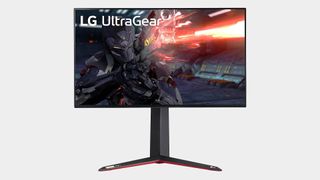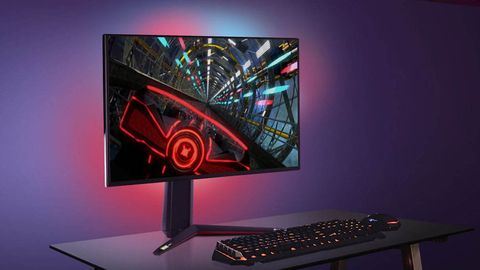Our Verdict
LG's latest 4K 144Hz panel is a peach, but doesn't offer a genuine HDR experience
For
- Luscious 4K NanoIPS panel
- Buttery smooth 144Hz responses
- Sleek slim-bezel design
Against
- Only 16 edge-lit dimming zones
- Not a true HDR experience
- Expensive
PC Gamer's got your back
The LG UltraGear 27GN950 is a frankly fabulous gaming panel. The LG UltraGear 27GN950 is an infuriatingly flawed gaming panel. Take your pick, because it's all true. And it sums up everything that’s variously great and yet also a little grim about today’s gaming monitor market.
But let’s not get ahead of ourselves. First, some speeds and feeds. The LG UltraGear 27GN950 is a new entrant into the busy 27-inch, 4K, 144Hz segment. Priced around £950 in the UK and a more appealing $800 Stateside, the 27GN950 is something of a ‘tweener in this space when it comes to both cost and specifications.
The most obvious shortcoming, compared to similar but even pricier screens, involves HDR implementation. The 27GN950 does support HDR, including local dimming, and comes complete with VESA’s DisplayHDR 600 certification. However, the local dimming comprises just 16 edge-lit zones, which doesn’t bode well for a true HDR experience.
Pixel response is another tricky area. LG proudly touts that the 27GN950’s NanoIPS panel delivers 1ms responses. But that claim comes with various caveats, regarding the precise GTG response profile in question, and only applies when the monitor is running in the most aggressive of its three pixel overdrive modes.
Screen size - 27-inch
Panel technology - NanoIPS
Native resolution - 3,840 x 2,160
Refresh rate - 144Hz
Response time - 1ms
Contrast - 1,000:1
Brightness - 400 nits (typical)
Inputs - 2x HDMI 2.0, 1x DisplayPort 1.4
Other - G-Sync Compatible, FreeSync Premium, 2x USB 3.0 hub
MSRP - $799
Another potential issue, depending on your precise usage model, is the absence of HDMI 2.1 support. That’s significant, because it limits this monitor to 4K at 60Hz via HDMI and this prevents high-refresh gaming with next-gen consoles. The full 144Hz 4K experience is only available with a DisplayPort interface. If you’re a pure PC gamer, that may not matter, but it’s still an oversight and a disappointing limitation at this price point. While we’re talking inputs, there’s no USB Type-C either, which is pity.
If that sounds like a litany of negatives, get ready for the counter attack.
That 1ms response claim may be qualified, but LG’s NanoIPS panels are still the quickest in the IPS sector. What’s more, with both 10-bit colour and a very impressive 98 per cent coverage of the DCI-P3 gamut, the 27GN950 is a seriously high fidelity monitor. LG reckons it’s as good for content creation as it is for gaming.
The specs certainly back that claim up. And thanks to support for Display Stream Compression, you can have that full colour accuracy at the same time as running at 144Hz refresh and native 3840 x 2160 resolution.






To that you can add compatibility with both Nvidia’s G-Sync and AMD’s FreeSync adaptive refresh, slick slim-bezel design, and LG’s Sphere Lighting 2.0 RGB visual theatrics. Oh, and the minor matter that, you know, this is a 4K IPS monitor that runs at fully 144Hz refresh.
But what of the actual real-world experience? This is an awfully pretty panel. LG’s default calibration is virtually faultless, with impeccable detail in both black and white scales. Beyond the strict metrics, it’s a seriously vibrant and punchy display in terms of image quality on the Windows desktop.
This screen pops.
Hop in game and it’s just as impressive. We’ll never tire of the buttery smooth goodness that is 144Hz. But combined with the crazy-sharp detail that comes with the 4K pixel grid, well, it’s pretty special. The catch, of course, is that you’ll need one heck of a GPU to make the most of the 144Hz refresh while running at 4K, though that just got a little more realistic with the release of a slew of new graphics cards from both Nvidia and AMD.
All is not, however, entirely picture perfect with the LG UltraGear 27GN950. For starters, there’s no avoiding the fact that IPS panels, even really good ones like this, still suffer from a little of that characteristic glow. It’s not an issue most of the time, but it’s definitely visible at the screen extremities when you’re deep underground in darker scenes of games like Metro Exodus.
Speaking of which, Metro also supports HDR, which is another weak point for the 27GN950. Quite frankly, those 16 edge-lit local dimming zones do not a true HDR panel make. This is a much more convincing monitor taken as a really excellent SDR panel. As an HDR display, it's disappointing.

Then it's back to those pixel response shenanigans. The most aggressive pixel overdrive setting suffers from some fairly obvious overshoot and therefore ghosting. But in subjective terms, the medium overdrive setting makes for pretty speedy pixels, especially for an IPS monitor, even if you’re not getting the full 1ms performance, claimed or otherwise. Factor in little to no discernible input lag, no doubt thanks to the 144Hz refresh, and you have a spectacular gaming experience.
All of which means the new LG UltraGear 27GN950 is a tricky panel to characterise. It certainly delivers on its core functionality of 4K with 144Hz refresh and quick responses. The colour fidelity of the NanoIPS panel is outstanding, too.
But some of the finer details and added features, including HDR and response aren’t unambiguous wins. Meanwhile, the lack of HDMI 2.1 and USB Type-C are a little limiting, especially looking forward. While you might not want to plug in a console or drive this monitor with a laptop today, better support for those usage models could come in handy in future. At this price point, they’re hardly unreasonable asks.
Were it up to us, we’d be tempted to strip out the limited HDR support and save a little cost. But then we could say that about an awful lot of current monitors with poor HDR implementations. As it is, this is a very fine, but slightly flawed, gaming monitor that leaves us wanting just a little bit more for what is a significant amount of money.
LG's latest 4K 144Hz panel is a peach, but doesn't offer a genuine HDR experience

Jeremy has been writing about technology and PCs since the 90nm Netburst era (Google it!) and enjoys nothing more than a serious dissertation on the finer points of monitor input lag and overshoot followed by a forensic examination of advanced lithography. Or maybe he just likes machines that go “ping!” He also has a thing for tennis and cars.
